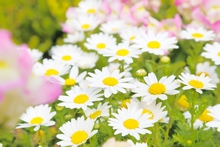Marguerite: The Secrets behind the Floral Emblem of Denmark - A Country In Love with Fairy Tales
November 14, 2016

Hello again, Naho here. As a book lover, reading has become part of my daily routine. Still, I remember that among all the different genres, fairy tales used to be one of my favorites as a child.
I believe most people would agree that H. C. Andersen is the world's most well-known fairy tale writer. So it shouldn't come as a surprise that the floral emblem of Denmark, the land where Andersen was born and raised, looks just like a flower popped out of a storybook.
The Climate of Denmark and Growing the Beautiful Marguerite
The floral emblem of Denmark is the marguerite. It grows around 2-3 feet tall, and after a certain period of time, the part of the stem that's near the soil grows rougher in texture and turns light brown in color, which resembles the bark of a tree. Precisely because of this, marguerites are also called "Spring Daisy of A Tree" (Mokushunguku) in Japanese. The flower features a single bloom, and the petals are generally white or yellow.
Some people see marguerite and daisy the same type of flower. Strictly speaking, however, "daisy" often refers to a particular species used in French-styled gardening, which was created through a process of selective breeding. One of the differences is that daisies tend to have larger and fuller blooms.
Marguerites are vulnerable to high-temperature and humid environments, and the growth of the flower can decline significantly when it gets too warm. In the case of a houseplant, the flowerpot should be moved to a well ventilated area before midsummer and direct exposure to sunlight should also be avoided.
It is warm in Denmark throughout the year, and the low humidity makes it both a lovely place to live and a perfect environment for the cultivation of marguerites, maybe that's why marguerites became so broadly appreciated by Danish people.
Andersen's Home Country: A Land of Fairy tales
With Marguerites - lovely flowers that seem to have popped out of a picture book - as its national flower, Denmark has long been a land of fairytales. Yet the most well-known among all are undoubtedly those written by Andersen. Thumbelina, the Little Mermaid, the Emperor's New Clothes, the Ugly Duckling, and the Little Match Girl are only a few of the stories that have influenced one generation after another, regardless of age and nationality.
In praise of his remarkable achievements, the government of Denmark honored Andersen by featuring a portrait of him on the old 10 Kroner banknote. Furthermore, in the capital city of Copenhagen stands a statue of the Little Mermaid, historical documents of the Royal Danish Ballet are also available for viewing. In Andersen's hometown Funen, one can visit H.C. Andersen's Childhood Home, as well as the Hans Christian Andersen museum. These establishments have all become popular tourist destinations.
In memory of Andersen's contribution to world literature, the International Board on Books for Young People (IBBY) inaugurated the Hans Christian Andersen Award in 1956. The award is also known as the "Nobel Prize for Children's Literature".
Marguerite the Flower and Margrethe the Queen
The origin of the name 'marguerite' comes from the Greek word margarites (Μαργαρίτες), meaning "pearls". Spelt "Margrethe" in Danish, it also happens to be the name of the current Queen of Denmark.
It is believed that the pearly petals of marguerites symbolize Innocence and Balance, and one might say that it is the perfect flower for a country where the spirit of equality is so highly respected.
Related Services
| << The Baltic Tiger―Estonia: Its Innovations and Language | Economic Power and Unique Culture - Exploring the Potential of Norwegian Translation >> |
To Contact Us Regarding Our Translation Services
For urgent needs, call:
+81-3-5730-6133
